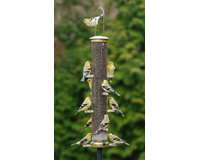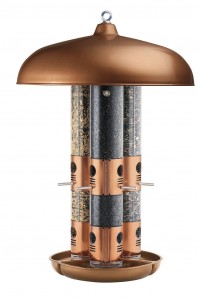-
Keep Thistle Feeders out Year Round
If you adore the vibrant yellow plumage of Goldfinches, it’s best to keep thistle feeders out year round. Thistle seed, also called nyjer is enjoyed not only by Goldfiches, but Indigo Buntings and Pine Siskins relish this seed too. One of the benefits of thistle is that it will not germinate, so there are no worries of sprouting weeds below your feeder. Another is that Goldfinches will sit at your feeder pecking seed after seed (to feed their brood) so it’s easy to view the charming songbirds. Both their song and disposition make the American Goldfinch a favorite among many backyard birders.
A common drawback to the very long, tubular style thistle feeders is that seed gets compacted at the bottom and tends to draw moisture if always filled from the top. Some feeders can be filled from the top or bottom. Remember to dump old seed and keep feeders clean. The three-tube thistle feeders also tend to distribute the seed more evenly, thus eliminating the problem of packed seed at the bottom.
-
A Tube Birdfeeder: Perch or Cling?
To Perch or Cling? Tube feeders come in a multitude of styles, accommodating nyjer seed, peanuts, and most birdseed mixes. Depending on what birds you’re looking to attract, and what you’re feeding should dictate the type of tube birdfeeder you’ll use.
For attracting Goldfinches with Thistle or Nyjer seed, both types of feeders work well. The advantage to a clinging-type feeder is that more feeding space is available, you’ll likely see more birds at the feeder at one time.
If you’re looking to attract multiple species with Black Oil Sunflower seed for example, a tube feeder with perches will allow each bird its own space.
Both types of work well, the important thing is to keep fresh food available, and keep feeders clean to prevent the spread of bacteria among gathering birds in your yard.


 To Perch or Cling? Tube feeders come in a multitude of styles, accommodating nyjer seed, peanuts, and most birdseed mixes. Depending on what birds you’re looking to attract, and what you’re feeding should dictate the type of
To Perch or Cling? Tube feeders come in a multitude of styles, accommodating nyjer seed, peanuts, and most birdseed mixes. Depending on what birds you’re looking to attract, and what you’re feeding should dictate the type of  Both types of work well, the important thing is to keep fresh food available, and keep feeders clean to prevent the spread of bacteria among gathering birds in your yard.
Both types of work well, the important thing is to keep fresh food available, and keep feeders clean to prevent the spread of bacteria among gathering birds in your yard.